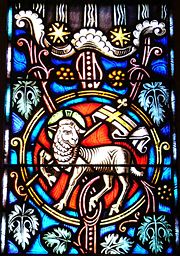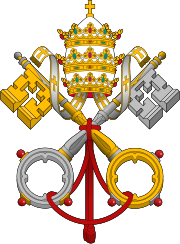Agnus Dei

Agnus Dei is a Latin term meaning Lamb of God, and was originally used to refer to Jesus Christ in his role of the perfect sacrificial offering that atones for the sins of humanity in Christian theology, harkening back to ancient Jewish Temple sacrifices. See Lamb of God for an explanation of this. Agnus Dei is used to refer to several things related to this imagery.
Contents |
Art and sacramental


In ecclesiastical art, an Agnus Dei is a visual representation of Jesus as a lamb holding a cross. The cross normally rests on the lamb's shoulder and is held in its right foreleg. Often the cross will have a white banner suspended from it charged with a red cross (similar to St George's Cross), though the cross may also be rendered in different colours. Sometimes the lamb is shown lying atop a book with seven seals hanging from it. This is a reference to the imagery in the Book of Revelation 5:1-13, ff. Occasionally, the lamb may be depicted bleeding from the area of the heart (Cf. Revelation 5:6), symbolizing Jesus' shedding of his blood to take away the sins of the world (Cf. John 1:29, 1:36).
In the Roman Catholic Church it is also a tablet of wax stamped with a representation of Jesus as a lamb bearing a cross, then blessed by the Supreme Pontiff as a sacramental.
The Moravian Church uses an Agnus Dei as their seal with the surrounding inscription Vicit agnus noster, eum sequamur ("Our Lamb has conquered, let us follow him.").
Although the depiction of Jesus as the Lamb of God is of ancient origin, it is not used in the liturgical iconography of the Eastern Orthodox Church. The reason for this is that the depictions of Jesus in the Orthodox Church are anthropomorphic rather than symbolic, as a confession of the Orthodox belief in the Incarnation of the Logos. However, there is no objection to the application of the term "Lamb of God" to Jesus. In fact, the Host used in the Orthodox Divine Liturgy is referred to as the Lamb (Greek: άμνος, amnos; Slavonic: Агнецъ, agnets).
Liturgy
In the Mass of the Roman Rite and also in the Eucharist of the Anglican Communion, and the Western Rite of the Orthodox Church the Agnus Dei is the invocation to the Lamb of God sung or recited during the fraction of the Host.[1] It is said to have been introduced into the Mass by Pope Sergius I (687–701).[2]
Based upon John the Baptist's reference in John 1:29 to Jesus ("Behold the Lamb of God that taketh away the sin of the world"), the text in Latin is:
- Agnus Dei, qui tollis peccata mundi, miserere nobis.
- Agnus Dei, qui tollis peccata mundi, miserere nobis.
- Agnus Dei, qui tollis peccata mundi, dona nobis pacem.
which means:
- Lamb of God, who takes away the sins of the world, have mercy upon us.
- Lamb of God, who takes away the sins of the world, have mercy upon us.
- Lamb of God, who takes away the sins of the world, grant us peace.
The following three versions of the Agnus Dei are particularly common in English-speaking churches. They are all found, for example, in the Church of England's Common Worship liturgical resources.
- Lamb of God, you take away the sin of the world, have mercy on us.
- Lamb of God, you take away the sin of the world, have mercy on us.
- Lamb of God, you take away the sin of the world, grant us peace.
- Jesus, Lamb of God, have mercy on us.
- Jesus, bearer of our sins, have mercy on us.
- Jesus, redeemer of the world, grant us peace.
- O Lamb of God, that takest away the sins of the world, have mercy upon us.
- O Lamb of God, that takest away the sins of the world, have mercy upon us.
- O Lamb of God, that takest away the sins of the world, grant us thy peace.
Notice that the verse John 1:29 has "sin of the world" rather than "sins of the world".
The General Instruction of the Roman Missal, § 83, states: "The supplication Agnus Dei, is, as a rule, sung by the choir or cantor with the congregation responding; or it is, at least, recited aloud. This invocation accompanies the fraction and, for this reason, may be repeated as many times as necessary until the rite has reached its conclusion, the last time ending with the words dona nobis pacem (grant us peace)."
Historically, in Requiem Masses, the first two invocations ended with "dona eis requiem" (give them rest) instead of "miserere nobis", and the last with "dona eis requiem sempiternam" (give them rest eternal).
The priest again uses the phrase "Lamb of God", in a more complete quotation from John 1:29, when displaying the consecrated Host (or the Host and Chalice) to the people before giving them Holy Communion. He says: "Ecce Agnus Dei, ecce qui tollit peccata mundi. (Behold the Lamb of God, behold him who taketh away the sins of the world.) Happy are they who are called to His Supper."
Famous composers have set to at times elaborate music this part of the Ordinary of the Mass.
The Agnus Dei chant also appears in the Eucharistic liturgies of other Communions. Lutherans and (usually) Anglicans almost always use it prior to or at the beginning of the administration of Holy Communion. Lutheran celebrants will often genuflect at the beginning of the three phrases.
In the Book of Common Prayer of The Episcopal Church, the Agnus Dei is listed (along with Pascha Nostrum) as one of several Fraction Anthems that may be used at the breaking of the bread.
Music
This liturgical text has been set to music by many composers, usually as part of a Mass setting, but sometimes it stands alone, e.g. it is the lyrics for the choral arrangement of Samuel Barber's Adagio for Strings.
Agnus Dei is also the name of several other songs, which may not have the traditional words:
- The atmospheric opening piece from Elliot Goldenthal's Alien³ score.
- The instrumental music played during the evacuation scene in Oliver Stone's Platoon.
- It was also sampled by Puff Daddy for the intro on his album No Way Out.
- Trains and Winter Rains single by Irish musician Enya, taken from the album And Winter Came....
- A song on Rufus Wainwright's Want Two album.
- A contemporary Christian praise song written by Michael W. Smith first released on his 1990 CD Go West Young Man. Later Smith performed it on his 2001 CD Worship. The song was subsequently covered by Third Day on their 2000 CD Offerings: A Worship Album. Donnie McClurkin has recorded a rendition of the song on his 2005 CD entitled Psalms, Hymns and Spiritual Songs. However, the text of this version does not bear any resemblance to the original historical texts.
- Contemporary Christian musician Rich Mullins modeled the first half of his 1993 CD A Liturgy, a Legacy, & a Ragamuffin Band after an orthodox liturgy. The song "Peace (A Communion Blessing from St. Joseph's Square)" relates to this part of the liturgy.
- Ross Parsley performed Agnus Dei on the album "Above All Worship", produced by Integrity's Hosanna Music in 2002. The same song was also re-released on the album "Real Men Worship", also produced by Integrity. Lyrics written by Michael W. Smith.
- The name of an instrumental produced by Asaki for Drummania 9/Guitar Freaks 10.
- The name of a song by Mylene Farmer.
- The name of a song by Funeral Mist.
- The name of a CD single produced by Janus.
- The group Bel Canto set the Agnus Dei to music on the holiday compilation CD Winter, Fire & Snow.
- Guy Gross set a version of Agnus Dei to music in a funeral scene in the tv series Farscape.
- A song track from the Namco videogame Ace Combat 04 (specifically, the background music for the final mission, "Megalith"). This rendition of Agnus Dei is properly called "Megalith-Agnus Dei" and features a 4-part chorus arrangement and a mix of classical and techno elements.
- A track on the Michael Garrick Jazz Orchestra album "Yet Another Spring".
- The boys' choir Libera also did their own variation on the piece "Agnus Dei"
- Orchestral Manoeuvres in the Dark's "Agnus Dei" from their Liberator album.
- Sung by choir during pivotal scenes in the best-selling PC game Homeworld.
- Act 5 of John Rutter's Requiem
- Choral work by Morten Lauridsen Paul Salamunovich, Conductor Los Angeles Master Chorale
- The Agnus Dei is heard at parts throughout the film Jose Rizal. Its music is composed by Nonong Buencamino, and chanted by a choir composed of tenors and basses.
- The newly found choir boy Andrew Johnston, has done his very own rendition of Angus Dei on his Debut album "One Voice"
References
- St Leonards Church, Speeton Has a fine example of a carved Norman Agnus Dei
- ↑ See "Agnus Dei" article from The Catholic Encyclopedia
- ↑ Lives of Orthodox Western Saints by Reader Daniel Lieuwen (St Nicholas Orthodox Church, McKinney TX)
|
Gregorian chants of the Roman Mass |
||
|---|---|---|
|
Ordinary: |
Kyrie | Gloria | Credo | Sanctus | Agnus Dei | Ite missa est or Benedicamus Domino |
|
|
||||||||||||||||||||
